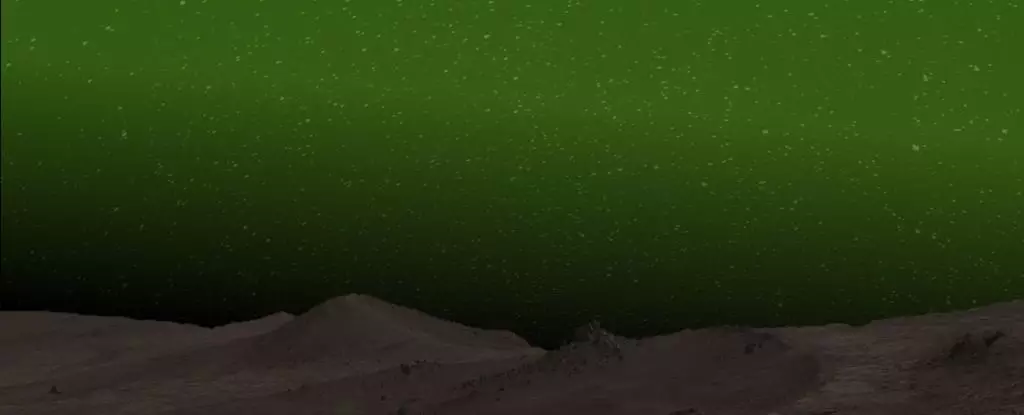On March 18, 2024, an extraordinary event took place that has forever changed our understanding of Mars. The Perseverance rover, stationed in the Jezero Crater, became the first machine to capture live footage of a shimmering green aurora in the Martian skies—an unprecedented achievement in planetary science. While auroras have been previously documented on Mars, this instance marked the first detection of an aurora visible to the naked eye. The implications of this discovery extend far beyond aesthetics; they open up new and more affordable avenues for studying the interactions between solar particles and Martian atmospheric conditions.
Scientist Elise Wright Knutsen from the University of Oslo highlighted the significance of this finding when she remarked, “The confirmation that visible auroras on Mars exist opens up new, hopefully simpler and cheaper, ways that we can study these processes.” This excitement underscores how understanding the auroras provides insight into solar wind interactions with planetary atmospheres, contributing to a broader comprehension of our solar system.
The Nature of Martian Auroras
Understanding the mechanics of Martian auroras requires delving into the nature of their formation. Just like Earth’s stunning auroras—often seen streaking across polar skies—Martian auroras result from complex interactions between charged particles ejected by the Sun and the planet’s magnetic field. However, the reality on Mars is strikingly different. Mars, with an atmosphere only about 2% as dense as Earth’s and a weak magnetic field relegated to localized patches, presents unique challenges for auroral phenomena.
While Earth’s magnetosphere provides robust protection against solar winds, Mars’s patchy magnetic fields allow for sporadic auroral activity. Observations previously made by scientists at ultraviolet wavelengths hinted that Martian auroras were much fainter than those on Earth, raising the question of whether these elusive emissions could ever be captured in visible light. The recent discovery marks a turning point, suggesting a richer understanding of these celestial phenomena.
How the Discovery Unfolded
The journey to detect these green Martian skies was not straightforward. The Perseverance rover’s instruments were primarily designed for daytime observations, complicating the process of capturing such a delicate light show during the night. The ensuing months were marked by anticipation and careful planning, with researchers keenly aware that the best opportunities to witness a Martian aurora typically coincide with energetic solar events, such as coronal mass ejections (CMEs).
On March 15, 2024, a significant CME released immense quantities of charged particles into space. This event set the stage for Perseverance to potentially observe the fleeting glow of ionized oxygen—an auroral phenomenon typically underappreciated in its beauty and significance. Explaining the process, Knutsen noted that by precisely measuring certain emissions at specific wavelengths—most notably at 557.7 nanometers—they could glean insights into the underlying processes leading to auroras.
Visual Awe and Scientific Insight
Upon successfully capturing the aurora, the team was met with an awe-inspiring sight. The Martian aurora displayed a green hue reminiscent of its terrestrial counterpart, yet with notable differences; rather than manifesting in intricate ribbons and structures, the entire Martian sky was uniformly aglow. This uniformity could signal distinct atmospheric properties on Mars, sparking curiosity on how planetary atmospheres function across our solar system.
Knutsen pointed out an intriguing possibility: though the rover managed to capture this stunning event, future explorers on Mars might still miss this visual spectacle due to the limitations of human color perception under dim lighting. The perspectives and experiences of astronauts traversing these landscapes could reveal a fascinating juxtaposition to the robotic views that currently dominate our understanding.
The Road Forward in Auroral Research
This remarkable discovery is just the beginning. Perseverance’s successful detection of Martian auroras is an invitation to further investigate these phenomena. In light of this finding, researchers are eager to develop new observational strategies and refine instruments capable of monitoring auroras under varying conditions. Knutsen and her colleagues are already laying plans to capture more auroras and dissect the intricacies of their production in relation to solar activity.
The scientific community now finds itself at a pivotal moment, possessing the tools and knowledge to unlock deeper mysteries of Martian and, by extension, planetary atmospheres. Questions linger about the solar storms that create these mesmerizing displays and the broader implications for planetary magnetism and atmospheric science across the solar system. As we stand on the brink of exploration, excitement swells over the potential for advancements that could redefine our knowledge of Mars—and maybe even our understanding of life beyond Earth.

